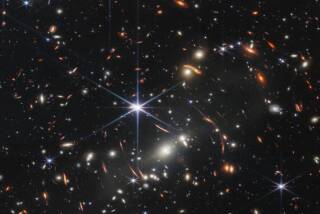Astronomers catch a strand of ‘cosmic web’ in quasar’s bright light
- Share via
Just as the sun causes a spiderweb’s near-invisible strands to glisten, a brightly shining quasar has lit up what scientists say is a massive filament of the universe’s cosmic web -- making it the first time a fragment of the web has been seen.
The discovery, led by UC Santa Cruz researchers using the Keck I Telescope in Hawaii and described in the journal Nature, could provide an unprecedented glimpse into the large-scale structure of the cosmos.
Scientists believe that the young universe was filled with matter -- both normal matter and dark matter -- that was mostly evenly distributed but slightly lumpy. Gravity eventually did its work, pulling the matter into pockets that eventually became enormous clusters populating the universe. These massive nodes remain linked by thin filaments of matter connecting them into what’s called a cosmic web.
Cosmologists have created computer models of what this cosmic web looks like. Even though it’s filled with gas and galaxies -- normal matter, the stuff we’re made of -- its structure is largely dictated by the gravitational influence of dark matter, the stuff that makes up roughly 84% of the matter in the universe.
The problem is, it’s been very difficult to actually see the cosmic web’s connective filaments -- the hydrogen gas wouldn’t shine brightly on its own, and dark matter cannot be seen, touched or otherwise directly detected (astronomers generally identify it by looking for its gravitational influence on other objects or light in the universe).
So scientists have searched for very bright objects, called quasars, to illuminate the diffuse, dim hydrogen gas in this web. A quasar is a powerfully luminous light source powered by a supermassive black hole at the center of a galaxy. Using this method, they found UM 287, a quasar sitting roughly 10 billion light years away that was shining on a massive nebula of hydrogen gas and causing it to emit ultraviolet light.
This nebula of glowing gas stretches 1.5 million light years long -- more than 10 times the width of our Milky Way galaxy. It’s the largest such nebula of hydrogen gas yet found, the scientists said. And it could stretch much longer -- after all, the quasar could just be illuminating a fragment of the gas.
The estimated mass of the gas seen in this filament is “more than ten times larger than what is typically found in cosmological simulations,” the study authors wrote. This means researchers may have a ways to go before they fully understand how this cosmic web is organized.
ALSO:
Rise and shine, Rosetta! Comet-hunter wakes up from 31-month slumber
Florida scientists strap cameras to alligator backs to study hunting tactics
Why do birds fly in a V? Endangered bird reveals amazing secret
A hunt for dark matter in a former gold mine







